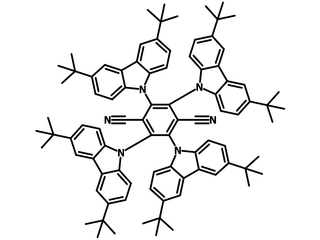4CzTPN-tBu
CAS Number 2153433-46-4
Dopant Materials, High Purity Sublimed Materials, Materials, OLED Materials, Red Dopant Materials, Semiconducting Molecules,4CzTPN-tBu, an orange dopant material in TADF devices
Available online in sensible quantities for priority dispatch, CAS No. 2153433-46-4, 2,3,5,6-tetrakis(3,6-di-tert-butylcarbazol-9-yl)-1,4-dicyanobenzene
2,3,5,6-tetrakis(3,6-di-tert-butylcarbazol-9-yl)-1,4-dicyanobenzene (4CzTPN-tBu) is the t-butylated derivative of 4CzTPN and it is sterically hindered with eight bulky tert-butyl peripheral end groups. Also due to the tert-butyl peripheral end groups, it becomes more soluble in most of the common organic solvents which makes all solution processing device possible.
4CzTPN-tBu as orange emitting layer, when blended in sky-blue delayed fluorescence molecule (4-(spiro[acridine-9,9’-fluoren]−10-yl)phenyl)(9-(3,5-di(carbazol-9-yl)phenyl)carbazol-3-yl)methanone (TCP-BP-SFAC) host, achieved record high power efficiency (PE) of 130.7 lm W-1, due to the balanced ambipolar transportation and high solid-state efficiency of TCP-BP-SFAC, and the effectively alleviated exciton quenching caused by the electron-trapping effect of 4CzTPN-tBu [1].
4CzTPN-tBu is an isomer to 4CzPN-tBu and 4CzIPN-tBu.
General Information
| CAS Number | 2153433-46-4 |
| Full Name | 2,3,5,6-tetrakis(3,6-di-tert-butylcarbazol-9-yl)-1,4-dicyanobenzene |
| Synonyms | 4CzTPN-Bu, 4CzTPNBu |
| Chemical Formula | C88H96N6 |
| Molecular Weight | 1237.74 g/mol |
| Absorption | λmax 282 nm in toluene |
| Fluorescence | λem 565 nm in toluene |
| HOMO/LUMO | HOMO = 5.50 eV, LUMO = 3.30 eV [1] |
| Classification / Family | Carbazole derivatives, Terephthalonitriles, TADF materials, Orange to red dopant materials, Sublimed materials |
Chemical Structure

Product Details
| Purity | Unsublimed >98.0% (1H NMR) |
| Melting Point | N/A |
| Appearance | Orange powder/crystals |
*Sublimation is a technique used to obtain ultra pure-grade chemicals. For more details about sublimation, please refer to the Sublimed Materials.
Device Structure
| Device Structure | ITO/HATCN (5 nm)/TAPC (50 nm)/TcTa (5 nm)/mCP (5 nm)/TCP-BP-SFAC (9 nm)/1 wt% 4CzTPNBu: TCP-BP-SFAC (5 nm)/TCP-BP-SFAC (6 nm)/PPF (5 nm)/TmPyPB (40 nm)/LiF (1 nm)/Al [1] |
| Color |
|
| Max. Current Efficiency | 104.2 cd/A |
| Max. EQE | 31.1% |
| Max. Power Efficiency | 130.7 Im/W |
| Device Structure | ITO/MoO3/NPB/mCP/PADPO:DMAC-DPS:4CzTPN-Bu/PADPO/Bphen/LiF/Al [2] |
| Color |
|
| Max. Current Efficiency | 63.7 cd/A |
| Max. EQE | 20.3 % |
| Max. Power Efficiency | 67.8 Im/W |
| Device structure | ITO/HATCN/TAPC/DBP:TCTA/4CzTPNBu:BDMAC-XT:CBP/TCTA/DCP-BP-DPAC:PPF/PPF/TmPyPB/LiF/Al [3] |
| Color |
|
| Max. Current Efficiency | 53.3 cd/A |
| Max. EQE | 23.0 % |
| Max. Power Efficiency | 64.4 Im/W |
MSDS Documentation
Literature and Reviews
- Achieving Balanced Electrical Performance of Host Material through Dual N-P=O Resonance Linkage for Efficient Electroluminescence, H. Li et al., ACS Appl. Mater. Interfaces, 14 (22), 25834–25841 (2022); DOI: 10.1021/acsami.2c02745.
- Achieving High Electroluminescence Efficiency and High Color Rendering Index for All‐Fluorescent White OLEDs Based on an Out‐of‐Phase Sensitizing System, H. Liu et al., Adv. Funct. Mater., 31, 2103273 (2021); DOI: 10.1002/adfm.202103273.
- Symmetrical spirobi[xanthene] based locally asymmetrical phosphine oxide host for low-voltage-driven highly efficient white thermally activated delayed fluorescence diodes, R. Du et al., Chem. Eng. J., 392, 124870 (2020); DOI: 10.1016/j.cej.2020.124870.
